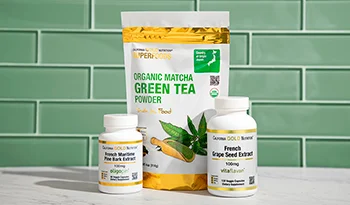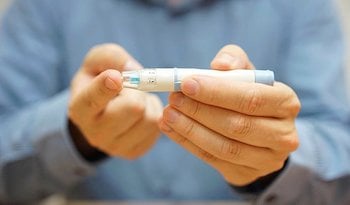氨基葡萄糖:它的益處、形態、關節健康等
免責聲明:本部落格不提供診斷⋯

什麼是氨基葡萄糖?
氨基葡萄糖是由葡萄糖(血糖)和含氮胺分子在體內合成的一種天然化合物。在體內,氨基葡萄糖刺激糖胺聚糖(GAGs)的生成,而後者是軟骨、肌腱和韌帶中的結構支撐分子。
氨基葡萄糖能緩解炎性反應嗎?
50多年前,世界衛生組織(WHO)進行了一項開創性的研究,發現隨着年齡的增長,人體會失去制造足量氨基葡萄糖的能力。
沒有足夠的氨基葡萄糖,軟骨就會失去其凝膠狀性質和作爲減震器的能力。糖胺聚糖(GAGs)是軟骨的結構支架,對於維持軟骨和其他關節成分的高含水量至關重要。如果沒有足夠的氨基葡萄糖,關節就會開始退化(無法正常工作)。氨基葡萄糖對炎性反應的過程也有一定作用。
在發現氨基葡萄糖與關節健康的聯系後,深入的科學研究顯示了補充氨基葡萄糖在幫助關節健康方面的基本原理和作用。氨基葡萄糖被世界上許多地方的醫學機構推薦爲修復關節健康問題的優選方案。
氨基葡萄糖有什麼作用?
對關節健康的益處
硫酸葡糖胺軟骨素(GS)是氨基葡萄糖的特好形式,也是促進關節健康的主要膳食補充劑。大量人體雙盲研究顯示,GS能顯著優化疼痛、關節功能指標和軟骨健康的血液標志物。一般來說,使用2至4周後就能看到這些益處,但也有證據表明,使用GS的時間越長,關節健康的益處就越大。
兩項時間特長的安慰劑對照試驗持續了三年。這些研究結果令人信服地表明,GS減緩了因關節老化或機械應力引起的軟骨損壞,X光片和臨牀評估結果都表明了這一點。研究結果還顯示,在這些研究中服用GS的人,即使在停止服用長達5年後,其全關節置換的次數也明顯減少。
預防損傷和修復
GS可以預防軟骨退化,尤其適用於關節勞損的運動員,如跑步者或參與足球、橄欖球、籃球或其他負重運動的運動員。GS還有助於輕微急性關節扭傷和拉傷的修復。一項雙盲研究顯示,每天服用1,500或3,000毫克的GS,並持續服用3個月的足球運動員,其血液中軟骨合成的標志物有所增加,而軟骨分解的比率則有所下降,進而證明了它對軟骨的保護作用。
氨基葡萄糖的食物來源
氨基葡萄糖沒有食物來源。只能通過膳食補充劑的形式攝取。大多數市售的氨基葡萄糖來源於甲殼素——蝦、龍蝦和螃蟹的外骨骼。此外,還有一種由玉米微生物發酵產生的素食形式的氨基葡萄糖。
氨基葡萄糖的形式:哪種極好?
硫酸葡糖胺軟骨素(GS)
硫酸葡糖胺軟骨素(GS)已經過廣泛研究,超過300項科學調查和30項雙盲研究都強調指出其有效性。它是氨基葡萄糖的優選形式,已被全球數百萬人廣泛接受。
GS已在70多個國家被注冊爲關節健康輔助藥品,證明了其上越的功效。
針對GS吸收和分布的人體研究顯示,其吸收率高達98%,令人贊嘆。一旦被吸收,它主要針對關節組織,促進軟骨、韌帶和肌腱的生成。這凸顯了它在幫助關節健康方面的關鍵作用。
鹽酸氨基葡萄糖(GHCL)
由於硫酸氨基葡萄糖(GS)的主要作用之一是促進糖胺聚糖(GAGs)的制造,因此在使用鹽酸葡糖胺軟骨素(GHCL)時,硫的缺乏可能意味着糖胺聚糖合成的減少。
因此,由於缺乏這一關鍵元素,僅使用GHCL不太可能取得與GS同樣出色的臨牀效果。
雙盲研究結果表明,在促進關節健康方面,GHCL並沒有比安慰劑更有效。一項雙盲、安慰劑對照的人類研究檢視了GHCL對受試者膝蓋健康的影響。受試者服用了500毫克的GHCL或安慰劑,每天三次,持續10周。結果顯示,兩組之間的差異沒有統計學意義。
在一項關於GHCL範圍極廣的研究中,1583例膝關節疼痛和關節功能不良的患者被隨機分組,連續24周每天接受1500毫克GHCL、1200毫克硫酸軟骨素、GHCL和硫酸軟骨素(劑量與單臂實驗組相同)、200毫克塞來昔布或安慰劑。結果顯示,在研究開始時患有中度至重度疼痛的患者中,同時服用GHCL和硫酸軟骨素的受試者的緩解率明顯高於安慰劑組(79.2%對54.3%)。然而,與安慰劑相比,服用GHCL或硫酸軟骨素的組沒有獲得任何益處。
N-乙酰葡糖胺(NAG)
N-乙酰葡糖胺(NAG)與硫酸氨基葡萄糖(GS)的不同之處在於,N-乙酰葡糖胺(NAG)沒有連接硫分子,而是有一部分乙酸分子。因此,人體對GS和NAG的處理方式也不同。氨基葡萄糖容易被人體吸收,而NAG則不然。由於多種原因,人體對NAG的吸收率很低:
- NAG很快就會被腸道細菌消化。
- NAG在腸道中與食物中的凝集素結合,形成凝集素-NAG復合物隨糞便排出體外。
- 很大一部分NAG會被腸道細胞代謝掉。
除了吸收問題外,關節組織也不能像氨基葡萄糖那樣很好地利用NAG。這些吸收和利用問題表明,NAG不大可能像GS一樣對關節健康有益。銷售NAG的公司聲稱NAG是一種對關節健康更好的氨基葡萄糖,但科學數據並不幫助這些說法。
劑量
GS的標準使用劑量爲每天1500毫克,單次服用可能會產生更好的效果。此外,運動員或關節磨損較嚴重的人可能需要將劑量增加到3000毫克,以幫助軟骨健康。
副作用和安心性
硫酸氨基葡萄糖具有良好的安心性記錄。研究認爲,其副作用與安慰劑無異,非常罕見,一般只限於輕微的胃腸道刺激。
氨基葡萄糖和軟骨素
人們經常將氨基葡萄糖與硫酸軟骨素(CS)放在一起討論。然而,根據大量的臨牀證據,只有硫酸氨基葡萄糖(GS)在作爲獨立制劑使用時,一直有數據證實其具有臨牀效能。大量研究顯示,將鹽酸氨基葡萄糖(GHCL)和硫酸軟骨素(CS)結合使用是有效的,而單獨使用GS則具有更顯著的臨牀效能。
此外,研究還表明,將硫酸氨基葡萄糖(GS)與硫酸軟骨素結合使用並不會比單獨使用GS帶來更大的益處。不過,當GS或GS+CS與甲磺酰基甲烷(MSM)結合使用時,可能會帶來更多的益處。同樣,將MSM與GHCL結合使用,可以通過供給必需的硫來加強GHCL的功效。
硫在GS的修效能果中起着至關重要的作用,替代硫可能會降低補充氨基葡萄糖的功效。這種營養物質對關節組織至關重要,因爲它能穩定軟骨、肌腱和韌帶的結締組織基質。此外,硫還有助於防止軟骨退化。因此,在糖胺聚糖(GAGs)中保持足夠的硫含量對於防止軟骨退化至關重要。
要點
總之,有關硫酸氨基葡萄糖的廣泛研究強調了它在幫助關節健康方面的重要性,以及它在促進整體健康方面的重要作用。
參考資料:
- Henrotin Y, Mobasheri A, Marty M. Is there any scientific evidence for the use of glucosamine in the management of human osteoarthritis? Arthritis Res Ther. 2012 Jan 30;14(1):201.
- Herrero-Beaumont G, Largo R. Glucosamine and O-GlcNAcylation: a novel immunometabolic therapeutic target for OA and chronic, low-grade systemic inflammation? Ann Rheum Dis. 2020 Oct;79(10):1261-1263.
- Conrozier T, Lohse T. Glucosamine as a Treatment for Osteoarthritis: What If It's True? Front Pharmacol. 2022 Mar 17;13:820971.
- Knapik JJ, Pope R, Hoedebecke SS, et al. Effects of Oral Glucosamine Sulfate on Osteoarthritis-Related Pain and Joint-Space Changes: Systematic Review and Meta-Analysis. J Spec Oper Med. 2018 Winter;18(4):139-147.
- Bruyère O, Honvo G, Veronese N, et al. An updated algorithm recommendation for the management of knee osteoarthritis from the European Society for Clinical and Economic Aspects of Osteoporosis, Osteoarthritis and Musculoskeletal Diseases (ESCEO). Semin Arthritis Rheum. 2019 Dec;49(3):337-350.
- Knapik JJ, Pope R, Hoedebecke SS, Schram B, Orr R, Lieberman HR. Effects of Oral Glucosamine Sulfate on Osteoarthritis-Related Pain and Joint-Space Changes: Systematic Review and Meta-Analysis. J Spec Oper Med. 2018 Winter;18(4):139-147.
- Setnikar I, Palumbo R, Canali S, et al. Pharmacokinetics of glucosamine in man. Arzneimittelforschung 1993; 43:1109–1113.
- Zhu X, Sang L, Wu D, et al. Effectiveness and safety of glucosamine and chondroitin for the treatment of osteoarthritis: a meta-analysis of randomized controlled trials. J Orthop Surg Res. 2018 Jul 6;13(1):170.
- Meng Z, Liu J, Zhou N. Efficacy and safety of the combination of glucosamine and chondroitin for knee osteoarthritis: a systematic review and meta-analysis. Arch Orthop Trauma Surg. 2023 Jan;143(1):409-421.
- Simental-Mendía M, Sánchez-García A, Vilchez-Cavazos F, et al. Effect of glucosamine and chondroitin sulfate in symptomatic knee osteoarthritis: a systematic review and meta-analysis of randomized placebo-controlled trials. Rheumatol Int. 2018 Jun 11. doi: 10.1007/s00296-018-4077-2.
- Lubis AMT, Siagian C, Wonggokusuma E, Marsetyo AF, Setyohadi B. Comparison of Glucosamine-Chondroitin Sulfate with and without Methylsulfonylmethane in Grade I-II Knee Osteoarthritis: A Double Blind Randomized Controlled Trial. Acta Med Indones. 2017 Apr;49(2):105-111.
- Nunes RM, Girão VCC, Cunha PLR, et al. Decreased Sulfate Content and Zeta Potential Distinguish Glycosaminoglycans of the Extracellular Matrix of Osteoarthritis Cartilage. Front Med (Lausanne). 2021 Apr 29;8:612370.
- Houpt J.B, McMillan R, Wein C, et al. Effect of glucosamine hydrochloride in the treatment of pain of osteoarthritis of the knee. J Rheumatol 1999;26:2423–2430.
- Sawitzke A.D, Shi H, Finco M.F, et al. The effect of glucosamine and/or chondroitin sulfate on the progression of knee osteoarthritis: a report from the glucosamine/chondroitin arthritis intervention trial. Arthritis Rheum 2008;58:3183–3191.
- Sawitzke A.D, Shi H, Finco M.F, et al. Clinical efficacy and safety of glucosamine, chondroitin sulphate, their combination, celecoxib or placebo taken to treat osteoarthritis of the knee: 2-year results from GAIT. Ann Rheum Dis 2010;69:1459–1464.
- Capps JC, Shetlar MR, Bradford RH. Hexosamine metabolism. I. The absorption and metabolism, in vivo, of orally administered D-glucosamine and N-acetyl-D-glucosamine in the rat. Biochim Biophys Acta 1966;127194–204.
- Tesoriere G, Dones F, Magistro; et al. Intestinal absorption of glucosamine and N-acetylglucosamine. Experientia 1972;28 770–771.
- Bruyere O, Pavelka K, Rovati LC, et al. Glucosamine sulfate reduces osteoarthritis progression in postmenopausal women with knee osteoarthritis: evidence from two 3-year studies. Menopause 2004;11:138–143.
- Reginster JY, Deroisy R, Rovati LC, et al. Long-term effects of glucosamine sulphate on osteoarthritis progression: a randomised, placebo-controlled clinical trial. Lancet 2001;357:251–256.
- Pavelka K, Gatterova J, Olejarova M, et al. Glucosamine sulfate use and delay of progression of knee osteoarthritis: a 3-year, randomized, placebo-controlled, double-blind study. Arch Intern Med 2002;162:2113–2123.
- Bruyere O, Pavelka K, Rovati LC, et al. Total joint replacement after glucosamine sulphate treatment in knee osteoarthritis: results of a mean 8-year observation of patients from two previous 3-year, randomised, placebo-controlled trials. Osteoarthritis Cartilage 2008;16;254–260.
- Bruyere O, Honore A, Ethgen O, et al. Correlation between radiographic severity of knee osteoarthritis and future disease progression. Results from a 3-year prospective, placebo-controlled study evaluating the effect of glucosamine sulfate.、Osteoarthritis Cartilage 2003;1:1–5.
- Nagaoka I, Tsuruta A, Yoshimura M. Chondroprotective action of glucosamine, a chitosan monomer, on the joint health of athletes. Int J Biol Macromol. 2019 Jul 1;132:795-800.
- Yoshimura M, Sakamoto K, Tsuruta A, et al. Evaluation of the effect of glucosamine administration on biomarkers for cartilage and bone metabolism in soccer players. Int J Mol Med 2009;24:487–494.

 作者 邁克爾·默里(Michael Murray)博士,自然療法醫師
作者 邁克爾·默里(Michael Murray)博士,自然療法醫師 


